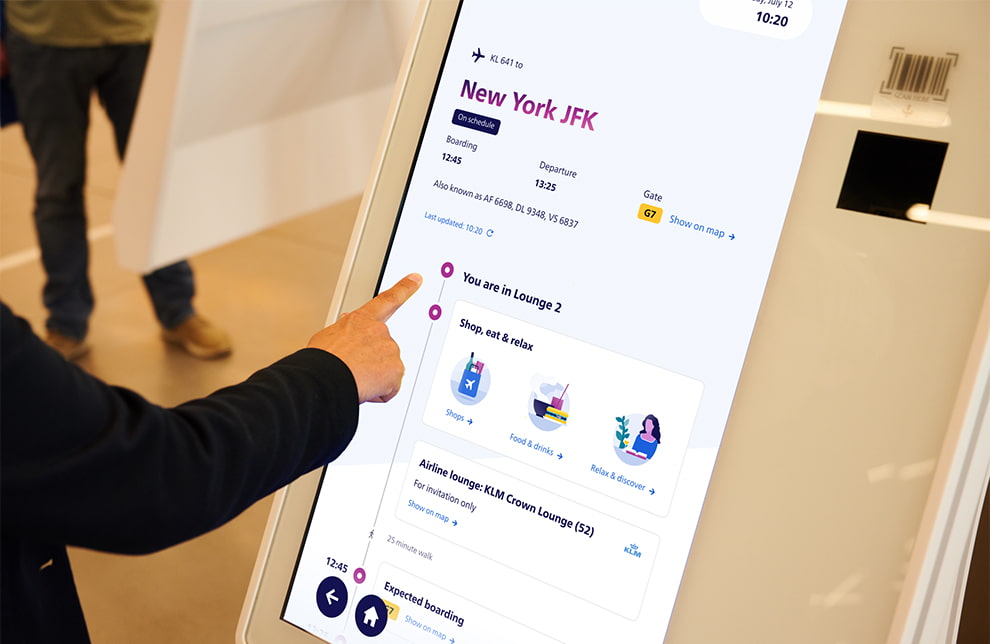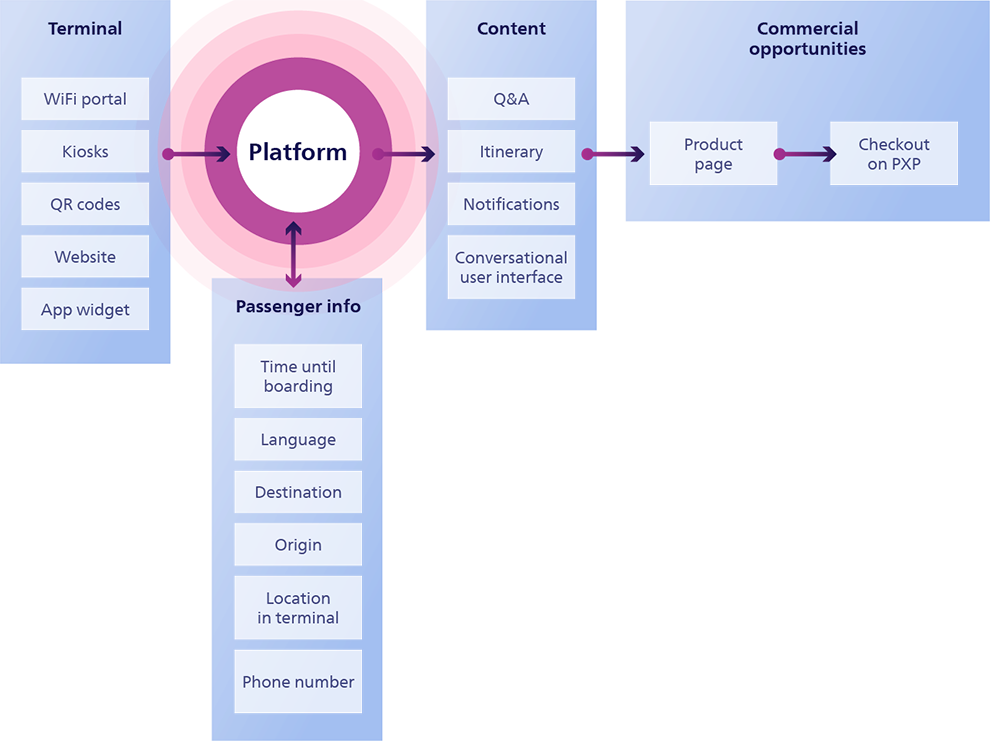Creating revenue opportunities at the terminal
In the bustling world of air travel, Tijn Borms, the Product Owner of Schiphol's Passenger Experience Platform, is on a mission to transform the way passengers experience airports. With a vision to cater to passengers in their moment of need, he's leading the charge to not only elevate airport experiences but also boost airport revenue. But what sets his approach apart? Discover his four commercial strategies that are reshaping airport dynamics and captivating passengers' attention.

In short:
- Elevate passenger experiences by providing more than just information.
- Use passenger data to make offers relevant and personal
- Become a marketplace and generate airport income
- Focusing on unit economics and passenger conversion rates
Tijn Borms is Director of Product of Schiphol's Passenger Experience Platform and strongly advocates for being relevant to the passenger in the moment of need. He sees a lot of opportunities for how airports can better understand their passengers to elevate their experiences and to increase non-aeronautical revenue. But they have some catching up to do, he adds. “Since travelling somewhere usually starts with booking a plane ticket, that’s where the customer information sits, first. The airline has a lot of information about the passengers, and the airport does not. This often limits commercial opportunities,” says Borms.
When asked who actually owns the relationship with the passenger, the airline’s or airport’s, Borms answers, “The airline and airport both serve the same customer and the combination is what creates a positive experience while travelling. Certain aspects of a trip can best be done by the airline, and others by the airport. Airports can do a much better job to make most of their passengers’ dwell time than airlines. An airport also has a better idea of walking times, waiting times, time slots for security lanes, or short connection priority tickets.“
1. Delight the passenger
The Passenger Experience Platform Tijn and his team are working on helps to provide passengers a stress-free journey by (proactively) answering any questions they have. This increases the passenger experience at airports and increases passenger engagement. But an added benefit is that the platform also opens up commercial opportunities, which, according to Borms, is something many airports struggle with.
“Many airports we’ve spoken with have traditionally focused on providing information, only. It’s the same for Schiphol. In 2018 Schiphol placed Self-Service Units, kiosks which provide wayfinding, information, and access to the platform, to answer questions passengers have. But there’s something beyond providing information. And that’s being proactive and helping them on their journey. And that’s something which can also generate revenue,” says Borms.
In an earlier interview, Borms explained that making the platform accessible from a mobile phone by simply scanning a QR code in the terminal will help reach passengers in their moments of need.
2. Use data to make it personal
According to Borms you need to be there when and where the passenger has a need. He explains that only passengers at the terminal access the platform. Which is different from the app or website which receives traffic from many users. It enables an airport to truly enhance the passenger's experience.
“When passengers scan their boarding passes, we know where they come from and where they are going to. We also know where they are in the terminal. We can use this information to provide a personal itinerary, with personalised offers: Hey, you travelled from Iceland to Alicante, need some sunblock?”
This information can also be used in the opposite way. An analysis of platform data could show that people who search for sunblock often come from Scandinavian countries. Insights like these could then lead to commercial opportunities to push ‘sunblock’ more to Scandinavian passengers.

3. Become a marketplace
“Providing information and answering questions is something the platform takes care of. By analysing what passengers are searching for, we can identify what their needs are. For some of those needs we have paid solutions and we can offer ways for those passengers to make a transaction. For example, when passengers search for how to get to Amsterdam; we can help them by offering a solution in the form of a train ticket, a taxi, car rental car or shuttle bus. We’re providing value to the passenger and while doing this it generates income for the airport.
Transactions can take place in different ways; we can send traffic to an external order flow using a QR code or a short URL. In the future, we can facilitate transactions on the platform itself. The QR code or short URL is very easy but there are extra steps involved which lowers the conversion compared to a direct checkout on a mobile phone using Apple Pay or Google. These require a deeper integration but typically yield a higher conversion rate.
Going back to the needs, we know that there’s a need for premium services like lounge access, hotels, eSIMs or call credit, and experiences like museums, zoos, and theme parks. These provide opportunities for airports.“

Note: From left to right; There are various ways in which passengers can access the Passenger Experience Platform. Passengers interact with the platform and find the information and content they are looking for. If relevant, the platform also enables passengers to purchase a product or service.
4. Optimise the inputs and outputs
Borms explains that the commercial opportunities for airports using the platform consist of two important components; the unit economics of the proposition (the profit you make on a transaction) and the conversion of passengers to that proposition (what percentage of passengers make a purchase).
“When you get to know these numbers the rest of the business case is simple. For example; how much traffic do you have on your airport WiFi-portal? What’s the revenue per passengers using that portal? What would it be if you would use the platform as the landing page for your WiFi- portal? It’s probably going to be more. And this doesn’t even include the positive impact on NPS and the indirect effect it has on non-aeronautical revenue. You can do the same for (parts of) your website or app. It is our vision to make this decision a no brainer for airports using the platform. In the future the platform will not cost you any money; it will generate it for you.”
Borms adds that the practice of requesting an email address on the WiFi-portal only works for a very limited number of passengers. “If your airport is the home base of many of your passengers this might make sense. But if you’re a destination or a hub it doesn’t. Let’s say you travel to a city for some sightseeing, and two weeks after the trip you receive an email with a discount for a certain perfume you can buy at the airport, well, then the opportunity is gone. As an airport, you need to seize the opportunity when they are at the airports and the platform can help you do it. When they’ve walked out the door or taken off, you’ve missed it.”
Subscribe to Aviation Solutions updates:
Discover what we're up to and receive a quarterly digest of everything related to Aviation Solutions.
Read the previous blogs
-
The Amsterdam Delay Allocation Method explained
Published on:Here’s how airports can improve delay insights by using already available data to get a deep understanding of the delay breakdown, enabling improvements.

-
Menzies’ 365 days with Deep Turnaround
Published on:Menzies Aviation shares their insights on how they transformed airport efficiency and communication with Schiphol's Deep Turnaround system over the past year.

-
Deep Turnaround featured on Future Airport
Published on:Future Airport's feature highlights Schiphol and Eindhoven Airport for their adoption of Deep Turnaround tech, revolutionizing airport operations.
